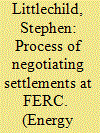| Srl | Item |
| 1 |
ID:
098623


|
|
|
|
|
| Publication |
2010.
|
| Summary/Abstract |
A decade ago, electricity distribution network revenues per customer in New South Wales (NSW) were twice those in Great Britain (GB). Recent price controls imply that by 2014 they will be nearly four times as high. This paper examines possible reasons for this. The main reason does not seem to be geography, operating environment or industry structure. GB and Victoria have managed to accommodate increasing demand at broadly constant or even declining costs and revenues while delivering higher quality of service, while NSW has not. The regulatory framework and the practice of the regulatory body within that framework seem relevant. Australian regulators have not used benchmarking techniques as the GB regulator has. Perhaps the most important explanatory factor is private ownership in GB and Victoria compared to state ownership in NSW. This could also impact on the nature and effectiveness of regulation.
|
|
|
|
|
|
|
|
|
|
|
|
|
|
|
|
| 2 |
ID:
092782


|
|
|
|
|
| Publication |
2009.
|
| Summary/Abstract |
In Canada, settlements between oil and gas pipelines and users have largely superseded the litigation of major pipeline toll cases since 1995. Quantitatively, from the first half to the second half of the period 1985-2007 the average number of pipeline toll hearing days in Canada fell by three-quarters. On average, settlements last more than twice as long as litigated outcomes and have cut regulatory processing times by about one third for gas pipelines and by about two thirds for oil pipelines, with the result that regulatory processing times per effective toll-year have fallen to 13% and 27% respectively of previous levels. Qualitatively, settlements have been used to determine prices, operating and capital cost projections, return on equity, service quality improvements, risk-sharing investments and information requirements. They were the vehicle by which multi-year incentive agreements developed rapidly for all pipelines. They have also been used to introduce light-handed regulation. They have provided a mechanism for fruitful collaboration between pipelines and their customers and have changed attitudes in the industry. Two key actions of the National Energy Board have facilitated settlements by clarifying expectations and property rights: its generic cost of capital decision that removes the market power of the pipeline and enables effective negotiation with users, and its willingness to judge a settlement by the reasonableness of the process leading up to it instead of imposing the Board's own values on the outcome.
|
|
|
|
|
|
|
|
|
|
|
|
|
|
|
|
| 3 |
ID:
116705


|
|
|
|
|
| Publication |
2012.
|
| Summary/Abstract |
Interstate gas pipelines and their customers presently settle about 90% of the rate cases set for hearing before the Federal Energy Regulatory Commission (FERC). The conventional regulatory litigation process is now only an occasional means of dispute resolution. This paper explains the settlement process, illustrating with the 12 section 4 rate cases brought by pipelines from 2008 and 2009. The paper also discusses and illustrates why parties prefer settlement to litigation, what difference it makes, which cases tend to settle, what might account for the increasing frequency of settlements over time, the recent phenomenon of pre-filing settlements and the recent settlement of section 5 cases brought by FERC. In contrast to many other regulatory jurisdictions, FERC Trial Staff play an active role in facilitating negotiation and settlement. They make an initial analysis 3 months after a pipeline files for a tariff rate increase. Thereafter, the regulatory aim is to bring the parties into agreement, not to determine an outcome and impose it upon them. This is a different role for the regulatory body than was previously apparent.
|
|
|
|
|
|
|
|
|
|
|
|
|
|
|
|